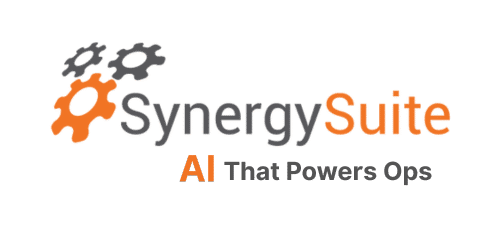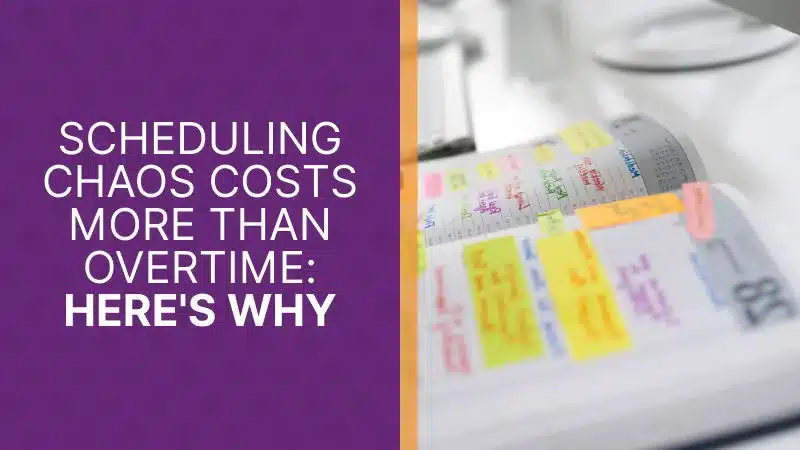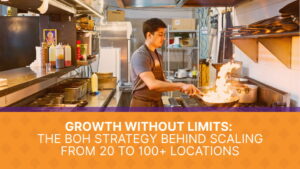You know that scene in disaster movies where everything looks fine on the surface, but the foundation is quietly cracking? The hero notices small signs —a rattling picture frame, rippling water— while everyone else misses what’s coming.
That’s what’s happening in restaurants right now. Managers obsess over overtime hours (the rattling frame) while missing the deeper operational cracks poor scheduling creates.
Let’s look beneath the surface of those time clocks.
The Hidden Cost of “Good Enough” Scheduling
Walk into any restaurant office and you’ll find the same scene: a manager hunched over spreadsheets from 1995, piecing together next week’s schedule like a puzzle with missing pieces.
This is the black-and-white world of traditional scheduling, gut feelings, sticky notes, and hope your best team member won’t call in sick.
But here’s what’s really happening:
- Talented employees quietly update resumes after another clopening shift.
- Customers walk out when you’re short-staffed at peak.
- Managers burn Sundays fielding coverage calls.
The cost? Far greater than any overtime check.
Meet the Real Players in Your Scheduling Drama
The Star Employee Turned Statistic
Two years with you. Reliable, customers love them, trains every new hire. But after three clopens last month, they quietly updated LinkedIn. Replacement cost: $5,864 (National Restaurant Association). Real loss? Knowledge, customer relationships, training investment.
The Ghost Customer
A family drives 20 minutes to try your restaurant, waits 15 minutes because schedules were based on last year’s averages, then leaves for the chain across the street. Tonight’s $80—and $2,000 lifetime value—lost.
The Overwhelmed Manager
Spends 12 hours weekly on “schedule Tetris.” That’s $15,000 in salary for work software could solve in 15 minutes.
What Poor Scheduling Really Costs
- The Overstaffing Tax: 4–6% of the bottom line lost from unnecessary labor costs.
- The Understaffing Penalty: Every understaffed rush = lost revenue + unhappy customers.
- The Turnover Tornado: At $6,000 per replacement, a 75% turnover rate costs a 50-person restaurant over $225,000 yearly.
Welcome to AI-Powered Scheduling
Competitors talk about labor optimization. We go further.
SynergySuite combines AI-powered forecasts with mobile-first employee empowerment—so scheduling not only saves money, but also improves retention.
Here’s how:
- AI-Powered Predictive Staffing: Machine learning uses sales history, weather, and local events to staff every shift optimally.
- Mobile-First Employee Empowerment: Staff swap shifts and request time off from their phones—fair distribution happens automatically.
- Manager Liberation: Leaders get 10+ hours weekly back to focus on training and customer experience.
- Real-Time Intelligence: Alerts flag labor spikes or projection changes so managers act proactively.
Real Results from Real Operators
Ampler Chicken implemented intelligent scheduling and transformed operations. Roger Menchaca, Senior Director of Operations, explains:
“The scheduling system has allowed us to deploy labor more effectively. We have much more effective daily control of food costs and labor. You can look at labor live, on the fly.”
The results? Operators save up to 8% on food and labor while giving managers 10+ hours back each week.
Your Choice: Chaos or Control
You can stay in the spreadsheet era of reactive scheduling.
Or move to AI + mobile-first scheduling that lowers costs, empowers staff, and boosts retention.
The technology exists. The AI engine is proven. The ROI is undeniable.
Ready for Predictable Profits?
Stop letting scheduling chaos drain your margins.
See how much scheduling chaos is costing you with our workforce optimization calculator—or talk to us about transforming your operations with SynergySuite.





